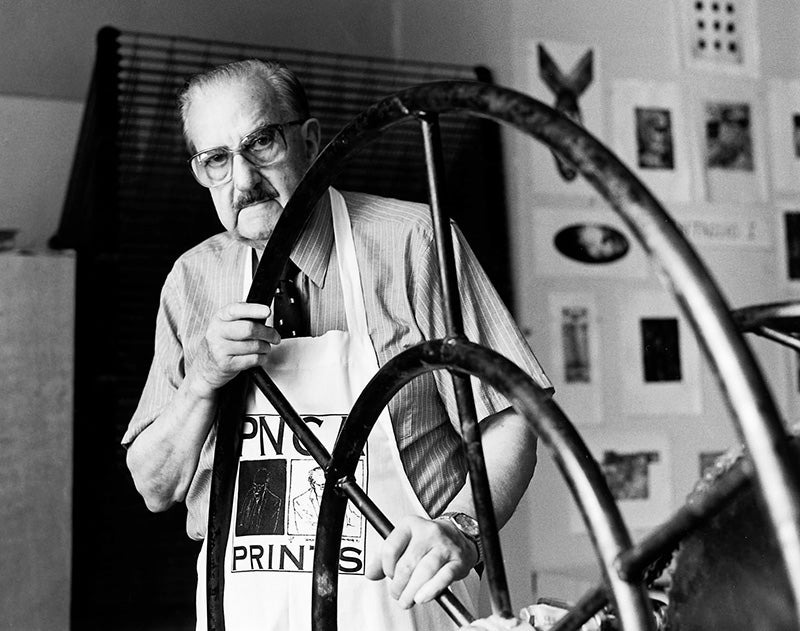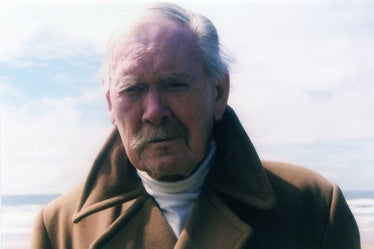The movie “Monuments Men,” which opens in theaters across the country Thursday, February 6, has a direct connection to the University of Oregon School of Architecture and Allied Arts. The movie tells the story of nearly 350 architects, artists, art historians, curators, and museum directors who joined the U.S. military specifically to save cultural treasures from destruction by the Third Reich in the waning days of World War II. Two of these “art heroes” spent significant time in A&AA: Gordon Gilkey, MFA ’36, and Mark Sponenburgh, who taught art at A&AA from 1946-1957.
The winter 2013 Oregon Quarterly profiled Gilkey, a printmaker who was born in 1912 near Scio on his grandfather’s Oregon homestead. In 1936 he was awarded the UO’s first MFA in printmaking, creating “a volume of original etchings documenting construction of the then-new University of Oregon Library. Ever resourceful, Gilkey had secured WPA funding to purchase the paper, inks, and plates necessary to produce his work, which was turned into a book,” writer Kimber Williams notes in the Oregon Quarterly story.
In 1939, as German panzers rolled into Poland, “Gilkey cringed at the potential for collateral damage—threats to not only Europe's great museums, but its historic architecture and bridges as well,” Williams writes. “Leveraging his connection to Roosevelt, he offered a bold suggestion: If the United States entered the war in Europe, the president should employ art experts along with his troops. ‘We ought to send specialists to tell them what not to blow up,’ Gilkey advised Roosevelt. Williams’ complete riveting story is online at the Oregon Quarterly website, Gilkey died in 2000.

Above: Gordon Gilkey
Sponenburgh, who is profiled on the movie website, enlisted in the U.S. Army in 1942 after the United States entered World War II. According to Elisabeth Walton Potter of the Society of Architectural Historians, in her obituary about Sponenburgh, “During the war, he served with the Corps of Engineers cartography section of the 9th Engineers Command. When hostilities ended in Europe in 1945, he volunteered for service in the Monuments, Fine Arts, and Archives program (MFAA) which, under auspices of the Allied Armies, was dedicated to recovering works of art confiscated by the Nazi regime.”
Sponenburgh was a sculptor, art historian, and educator, studying at the University of Michigan, Cranbrook Academy of Wayne State University, and elsewhere before volunteering for the war effort.
Upon his return from Europe in 1946, he joined the A&AA faculty. As Potter wrote: “His tenure there of eleven years encompassed teaching and research fellowships in Egypt and London. He was elected a Fellow of the Royal Society of Arts. In the early 1950s, he revised the university’s graduate program in sculpture and initiated a ground-breaking course sequence, the History of Sculpture. In 1957, his name first appeared on the membership roster of the Pacific Section of the Society of Architectural Historians. In the same year, Sponenburgh left UO to assist the government of Pakistan in creating a National College of Arts in Lahore. Forty years later, in 1997, he established an endowment fund at UO in support of graduate student research and a lectureship on sculpture.”
Sponenburgh, who died in late 2012, is profiled on the movie website as well as in numerous obituaries including The Oregonian, and A&AA.
The Monuments Men Foundation website offers more information about the astonishing work these men and women accomplished, both during and after the war. As the website notes, “Upon returning home, many of the Monuments Men and women had extraordinarily prominent roles in building some of the greatest cultural and educational institutions in the United States. They became directors and curators of world-renowned museums such as the Met, the MOMA, the National Gallery of the Cleveland Museum of the Toledo Museum of the Nelson-Atkins Museum of Art and many others. Other revered institutions, such as the New York City Ballet, the National Endowment for the Humanities, and the National Endowment for the Arts, were the tangible results of ideas of the Monuments Men.”

Above: Mark Sponenburgh
